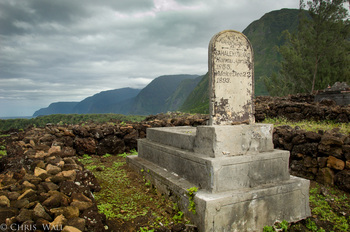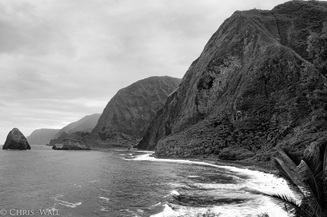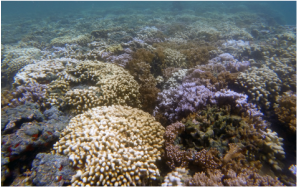
This last weekend I was blessed with the opportunity to visit the remote town and National Historic Park/Community of Kalaupapa on the island of Moloka'i. Moloka'i is just east of O'ahu in the Maui Nui Island Complex (Maui, Lanai, Moloka'i, Kahoolawe). In fact, from O'ahu you can see Moloka'i on the eastern horizon--but the two islands are dramatically different. For instance, Moloka'i has a population of < 8,000 compared to O'ahu's ~1 million.
The isolated community of Kalaupapa has a long history in Hawai'i, one that is both sacred and deep in emotional and cultural connection to the people of Hawai'i. The history of Kalaupapa extends back to the ancient Hawaiians that lived in this community during a period prior to European contact. However, Kalaupapa's role in Hawaiian history is most known beginning in the 19th century during the rule of the Hawaiian Monarch. In the late 1860s Hansen's Disease (leprocy) was introduced to the Hawaiian Islands. King Kamehameha V proclaimed that people with the disease were to be forcibly sent to Kalaupapa where they would spend the rest of their days in isolation away from the their families and their community. Approximately 8,000 people died in Kalaupapa, most of which were Hawaiians. Alongside the afflicted were many members of the Catholic clergy that spent time in Kalaupapa serving and engaging with Hansen's Disease patients; some gave their lives to this cause. While there is a cure for Hansen's Disease today, patients sent to Kalaupapa still live in the settlement today. The community in Kalaupapa is very special, and thanks to the larger community of Moloka'i and the National Parks Service, the sacred past of Kalaupapa has been preserved as a part of the history and heritage of Hawai'i.
The isolated community of Kalaupapa has a long history in Hawai'i, one that is both sacred and deep in emotional and cultural connection to the people of Hawai'i. The history of Kalaupapa extends back to the ancient Hawaiians that lived in this community during a period prior to European contact. However, Kalaupapa's role in Hawaiian history is most known beginning in the 19th century during the rule of the Hawaiian Monarch. In the late 1860s Hansen's Disease (leprocy) was introduced to the Hawaiian Islands. King Kamehameha V proclaimed that people with the disease were to be forcibly sent to Kalaupapa where they would spend the rest of their days in isolation away from the their families and their community. Approximately 8,000 people died in Kalaupapa, most of which were Hawaiians. Alongside the afflicted were many members of the Catholic clergy that spent time in Kalaupapa serving and engaging with Hansen's Disease patients; some gave their lives to this cause. While there is a cure for Hansen's Disease today, patients sent to Kalaupapa still live in the settlement today. The community in Kalaupapa is very special, and thanks to the larger community of Moloka'i and the National Parks Service, the sacred past of Kalaupapa has been preserved as a part of the history and heritage of Hawai'i.

I will never be capable of describing how truly special Kalaupapa is. The energy here is palpable. A seemingly untouched, rugged natural beauty; remnants of ancient Hawaiian traditions and culture (i.e., ahupua'a, and temple heiaus); the comfort of a small-town rich in historical architecture of 19th and 20th century Americana. And all of this, juxtaposed against a backdrop of cemetery plots and headstones silently proclaiming the unimaginable suffering and sadness that once lived in this place. I was honored to have been able to visit Kalaupapa, and spend time with the people in this community that are working to preserve it.

While in Moloka'i, I had some time to explore and take in the beauty of this remote coastline. The National Park Service has done an amazing job at serving this community and preserving its history, but there is always more work to be done. One thing I noticed, and was quite surprised to find, was the marine debris that had washed up on beaches in Moloka'i, and I would like to bring attention to this in the hopes of starting a discussion on how to remediate this problem.
Preserving the coastal lands and beaches is a full time job, and outside of the community marine debris can be found scattered across this beautiful coastline. This may be a surprise to you considering Moloka'i has such a small population. Despite this small local population and the remoteness of Kalaupapa, debris carried to the ocean from rivers, adrift from other neighboring islands, and abandoned/derelict fishing gear have found their way to this isolated place.
I imagine the debris problem in Kalaupapa is exacerbated by two causes: (1) limited access to this area and therefore limited observation and removal of debris, and (2) the financial and logistical constraints with removing such waste from this remove stretch of the north shore of Moloka'i (i.e., there are no roads into Moloka'i: there is a donkey trail and a landing strip for single propeller planes).
It is my hope that non-governmental organizations will be able to coordinate efforts with the National Parks Service and the Kalaupapa community to establish an effective way to remediate marine debris in Kalaupapa. However, marine debris is a a global problem, amplified by our use of plastics and non-degradable materials.
Preserving the coastal lands and beaches is a full time job, and outside of the community marine debris can be found scattered across this beautiful coastline. This may be a surprise to you considering Moloka'i has such a small population. Despite this small local population and the remoteness of Kalaupapa, debris carried to the ocean from rivers, adrift from other neighboring islands, and abandoned/derelict fishing gear have found their way to this isolated place.
I imagine the debris problem in Kalaupapa is exacerbated by two causes: (1) limited access to this area and therefore limited observation and removal of debris, and (2) the financial and logistical constraints with removing such waste from this remove stretch of the north shore of Moloka'i (i.e., there are no roads into Moloka'i: there is a donkey trail and a landing strip for single propeller planes).
It is my hope that non-governmental organizations will be able to coordinate efforts with the National Parks Service and the Kalaupapa community to establish an effective way to remediate marine debris in Kalaupapa. However, marine debris is a a global problem, amplified by our use of plastics and non-degradable materials.

Over 8 million tons of marine debris enter our oceans each year. However, it is important to remember that not all forms of marine debris are large--some are UV-degraded small pieces (micro plastics). Microplastics are particularly hard to remove due to its small size, and these debris can have devastating impacts on marine life that eat them, such as turtles, birds, and fish.
So how can you aid in stopping marine debris? First, no matter where you live don't litter! This trash will eventually find its way to a water way and the ocean. Second, if you see trash, pick it up! This is effective at beaches and more terrestrial habitats. And finally, we should all work to reduce our collective reliance on plastics and non-degradable products such as plastic bags, plastic water bottles, and the like. Wherever you live, look for groups that participate in waterway/beach cleanups. These are great opportunities to learn about your local aquatic habitats and to make an impact in reducing trash on land and in the sea. Contact the Sierra Club, Surfrider Foundation, or the Ocean Conservancy to get involved.
You can learn more about marine debris from the EPA (Trash Free Waters Program) and from NOAA (Marine Debris Program), and efforts to tackle marine debris in Hawai'i (Sustainable Coastlines Hawai'i).
So how can you aid in stopping marine debris? First, no matter where you live don't litter! This trash will eventually find its way to a water way and the ocean. Second, if you see trash, pick it up! This is effective at beaches and more terrestrial habitats. And finally, we should all work to reduce our collective reliance on plastics and non-degradable products such as plastic bags, plastic water bottles, and the like. Wherever you live, look for groups that participate in waterway/beach cleanups. These are great opportunities to learn about your local aquatic habitats and to make an impact in reducing trash on land and in the sea. Contact the Sierra Club, Surfrider Foundation, or the Ocean Conservancy to get involved.
You can learn more about marine debris from the EPA (Trash Free Waters Program) and from NOAA (Marine Debris Program), and efforts to tackle marine debris in Hawai'i (Sustainable Coastlines Hawai'i).
Matter of fact: The Ocean Conservancy has a marine debris petition up NOW to addressed to Secretary of State John Kerry (an advocate for marine conservationism). Visit their site for more information...


 RSS Feed
RSS Feed